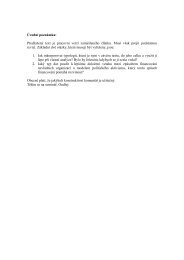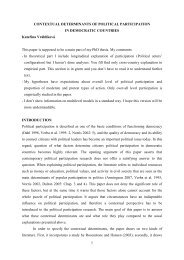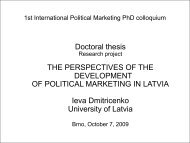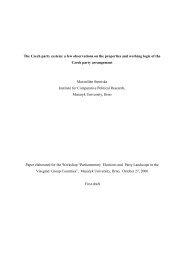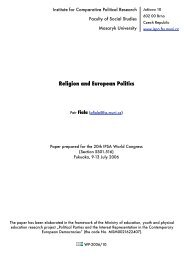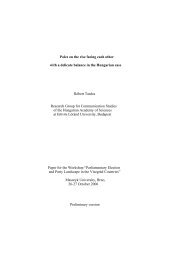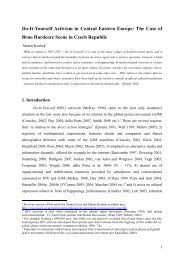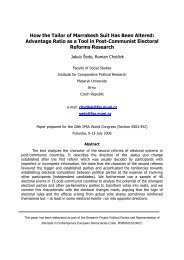Agrarian and Peasant Parties in the Czech Republic - Masarykova ...
Agrarian and Peasant Parties in the Czech Republic - Masarykova ...
Agrarian and Peasant Parties in the Czech Republic - Masarykova ...
You also want an ePaper? Increase the reach of your titles
YUMPU automatically turns print PDFs into web optimized ePapers that Google loves.
Union (Liberáln$ sociální unie /LSU/), which emerged <strong>in</strong> May 1991, thus once aga<strong>in</strong> brought<br />
toge<strong>the</strong>r <strong>Czech</strong>oslovak <strong>Agrarian</strong> Party (<strong>in</strong> <strong>the</strong> meantime, <strong>the</strong> party was renamed to <strong>Agrarian</strong> Party<br />
<strong>in</strong> late January) <strong>and</strong> Political Movement of Agricultural Cooperatives’ Members; besides <strong>the</strong>se<br />
subjects, <strong>Czech</strong>oslovak Socialist Party (#eskoslovenská strana socialistická /#SS/) <strong>and</strong> a <strong>Czech</strong><br />
branch of <strong>the</strong> Green Party (Strana zelených /SZ/) 3 took part <strong>in</strong> this enterprise. From <strong>the</strong> very<br />
emergence of LSU, <strong>the</strong> socialist <strong>and</strong> agrarian parties were its major elements which supplied huge<br />
majority of key programmatic priorities (Fiala, Mareš 1997).<br />
Establishment of this broad coalition proved to be a real success – <strong>in</strong> 1992 parliamentary election<br />
LSU got 5,84 % of <strong>the</strong> vote, or 6,06 % respectively (both chambers of <strong>the</strong> <strong>Czech</strong>oslovak federal<br />
parliament), while <strong>in</strong> <strong>the</strong> election to <strong>the</strong> <strong>Czech</strong> National Council it achieved its best result of 6,52<br />
% of <strong>the</strong> vote (which amounts to app. 422.000 votes). 4 However, this success should last for a<br />
short time only. Even when just after <strong>the</strong> election LSU entered <strong>in</strong>to closer touch with <strong>the</strong><br />
<strong>Czech</strong>oslovak Social Democratic Party (#eskoslovenská sociální demokracie /#SSD/) <strong>and</strong><br />
nursed some ambition to establish itself as relevant part of <strong>the</strong> opposition, disputes with<strong>in</strong> its<br />
constituent segments quickly elim<strong>in</strong>ated any hope <strong>in</strong> longer-term successful operation.<br />
In June 1993 <strong>Czech</strong>oslovak Socialist Party, hop<strong>in</strong>g to establish better relationship towards<br />
govern<strong>in</strong>g coalition, left LSU; five months later <strong>the</strong> Green Party followed its example <strong>and</strong> quit<br />
LSU as well. <strong>Agrarian</strong> Party, which to a serious extent considered LSU its own project, kept<br />
try<strong>in</strong>g to keep it alive, but did not manage to prevent it from marg<strong>in</strong>alization. Dur<strong>in</strong>g 1994 LSU<br />
was constituted as a separate party, while <strong>Agrarian</strong> Party rejected to merge <strong>and</strong> also cont<strong>in</strong>ued <strong>in</strong><br />
<strong>in</strong>dependent operation. This development was accompanied by decrease <strong>in</strong> electoral preferences,<br />
which at <strong>the</strong> turn of 1993/94 fell to 1 % <strong>and</strong> never recovered. Local elections <strong>in</strong> November 1994<br />
only reconfirmed agrarian parties lost <strong>the</strong>ir chance to achieve relevance <strong>and</strong> are on <strong>the</strong> way<br />
towards hopelessly m<strong>in</strong>or position – <strong>Agrarian</strong> Party got only 0,2 % of <strong>the</strong> vote (340 m<strong>and</strong>ates),<br />
while <strong>the</strong> Farmers’ Movement (Hnutí zem$d$lc% /HZ/, formerly known as Political Movement<br />
of Agricultural Cooperatives’ Members) achieved 0,3 % of <strong>the</strong> vote (680 m<strong>and</strong>ates).<br />
However, at that time ano<strong>the</strong>r attempt to build a relevant partnership was already under way, as<br />
s<strong>in</strong>ce late 1993 <strong>the</strong> <strong>Agrarian</strong> Party <strong>in</strong>itiated a series of negotiations <strong>in</strong>tended to create a group<strong>in</strong>g<br />
of centrist parties, which would be able to present an option alternative to more successful<br />
rightist <strong>and</strong> leftist parties. These negotiations, hav<strong>in</strong>g lasted approximately for one year,<br />
culm<strong>in</strong>ated <strong>in</strong> December 1994 by establishment of an electoral coalition called <strong>Czech</strong>-Moravian<br />
3 In <strong>the</strong> early 1990’s <strong>the</strong> Green Party was divided <strong>in</strong>to two adm<strong>in</strong>istrative branches – Moravian <strong>and</strong> <strong>Czech</strong>. See<br />
Kope#ek 2005: 1582, 1587.<br />
4 While it is impossible to make absolutely exact judgement, we can say – on <strong>the</strong> basis of pre-electoral public<br />
op<strong>in</strong>ion polls – that three parties constitut<strong>in</strong>g LSU (Political Movement of Agricultural Cooperatives’ Members<br />
left LSU before <strong>the</strong> 1992 election) supplied voters <strong>in</strong> approximately equal ratio.<br />
8



